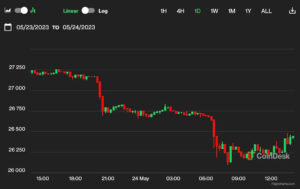Bitcoin, the largest cryptocurrency by market capitalization, has experienced a period of stagnation and volatility in recent weeks. The crypto markets finally witnessed a change of pace as investors reacted to concerns over UK inflation and warnings about the US debt ceiling stalemate. The release of the Federal Open Market Committee (FOMC) minutes further exacerbated market uncertainties, leading to a dip in Bitcoin prices. This article explores the ongoing trends surrounding Bitcoin amidst global economic concerns and the search for a catalyst to drive its resurgence.
Market Fluctuations and Regulatory Uncertainties
Bitcoin has been struggling to find stability, with its value hovering around $26,440, a decline of approximately 3% over the past 24 hours. This price level represents the lowest since May 12, when Bitcoin dropped below $26,000. During this period, cryptocurrency has faced challenges due to low trading volume and volatility, driven by concerns over the US government’s ability to meet its financial obligations and ongoing regulatory uncertainties in the crypto market.
Increased tension in financial markets has impacted both equities and digital assets. Fears of a possible US default and the lack of progress in debt ceiling negotiations have raised concerns among market participants. Financial institutions are restructuring assets and preparing for potential defaults, exerting additional pressure on the participants in the financial markets. These uncertainties have contributed to Bitcoin’s limited trading range and investor pessimism.
Correlation Between Equity and Crypto Pricing
The correlation between traditional equity markets and cryptocurrencies has been noticeable, with significant stock indexes experiencing a similar downward trend on Wednesday. The tech-focused Nasdaq, S&P 500, and Dow Jones Industrial Average (DJIA) all dropped, reflecting the impact of Janet Yellen’s cautionary remarks about the US potentially running out of money without a debt limit agreement. This correlation indicates that market sentiment and economic stability concerns can influence traditional and digital asset markets.
Inflationary Pressure and Interest Rate Hikes
The UK’s latest Consumer Price Index (CPI) figures revealed a higher-than-expected inflation rate of 6.8% in April, the highest since 1992. This data suggests that the Bank of England may need to continue raising interest rates, which has generally discouraged crypto market investors. The anticipation of further interest rate hikes contributes to the prevailing market uncertainty surrounding Bitcoin and other cryptocurrencies.
Lack of a Consistent Narrative
Bitcoin’s recent behavior has drawn comparisons to traditional safe-haven assets like gold. However, it still lacks a consistent narrative that drives investor decisions. Glen Goodman, author of “The Crypto Trader,” suggests that the crypto community is waiting for a significant event or disaster to unite around a common narrative. Speculation persists about potential triggers, such as a collapse of the US dollar or a major economic crisis, that could motivate investors to rally behind Bitcoin.
Looking Ahead
Bitcoin continues to face ongoing challenges amidst a backdrop of global economic concerns and regulatory uncertainties. The market remains sensitive to inflation rates, interest rate hikes, and geopolitical events. Until a new catalyst emerges to drive a unified narrative for Bitcoin, the cryptocurrency is likely to remain range-bound and volatile. Investors and market participants will closely monitor developments in the US debt ceiling negotiations and regulatory frameworks to gauge the future direction of cryptocurrencies.
In addition to the aforementioned factors affecting Bitcoin, it’s worth noting the growing interest and adoption of cryptocurrencies by institutional investors and major corporations. Despite the current market challenges, there is a gradual acceptance of digital assets as an alternative investment and store of value. High-profile companies, including Tesla, MicroStrategy, and Square, have allocated significant portions of their treasury holdings to Bitcoin, signaling a shift in perception and recognition of its potential long-term value.
Furthermore, governments and central banks worldwide are exploring the concept of central bank digital currencies (CBDCs) and implementing blockchain technology in their financial systems. This indicates a broader acceptance and integration of cryptocurrencies into the traditional financial landscape. The development of regulatory frameworks and increased institutional involvement could pave the way for a more stable and regulated crypto market, potentially attracting a broader range of investors and providing a more solid foundation for Bitcoin’s future growth.
It is essential to recognize that the cryptocurrency market remains highly speculative and subject to volatility. While long-term prospects for Bitcoin and other cryptocurrencies may be promising, investors should exercise caution and conduct thorough research before participating in the market. As the landscape evolves, staying informed about market trends, regulatory developments, and technological advancements will be crucial for navigating the crypto space effectively.
Bitcoin’s recent performance reflects the broader landscape of global economic uncertainties. The interplay between inflation, interest rates, debt ceiling negotiations, and regulatory concerns has contributed to Bitcoin’s stagnation and volatility. As market participants search for a unifying catalyst, Bitcoin’s resilience and potential as a safe haven asset continue to be tested. While the cryptocurrency market awaits a clearer narrative, investors should closely monitor economic developments and emerging trends to navigate the ever-evolving landscape of digital assets.
Read More:
The post Bitcoin Faces Uncertainty Amidst Global Economic Concerns appeared first on TechJuice.
from TechJuice https://ift.tt/MPihJtL





0 Comments